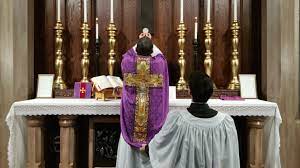The Latin Mass: an extraordinary sacrifice

The Latin Mass, while controversial, is an essential part of many Catholics’ lives
February 11, 2022
Until the 1960s, the Latin mass was the universal form of celebration in the Roman Catholic Church. However, after the Vatican II Council (1962-1965) met, the Church revised the mass to be said in the local vernacular. Since that period, the traditional Latin mass has been in a state of limbo, depending solely on who occupies the papacy. While there have been traditionalist groups that are schismatic, such as the Society of Saint Pius X (SSPX), most people who support the Latin mass are loyal Catholics and support the papacy very strongly. However, last summer, Pope Francis issued a motu proprio (“on his own impulse”) called Traditionis custodes (“Guardians of the Tradition”), which restricts the Latin mass and the right of priests to perform the sacraments in the traditional rite, claiming the Latin rite caused divisions in the Church. While I wholly support the papacy, I disagree with this restriction and believe it comes out of a pure misunderstanding of what the Latin mass is.
My first experience with the Latin mass was not too long ago, but I remember it clearly. As my friend and I sat in the car, waiting for the last mass to get out, we could hear the organ blaring from across the street. A few minutes later, we saw a procession from the mirror, which consisted of the priest and several altar boys, who led the congregation out of the Church. The most wonderful thing that I saw in that procession was the crucifix, which led the procession, raised high above all else so that it could be seen clearly. As I then went into the Church, the smell of incense struck my nostrils so strongly, but it made me feel a sense of reverence for what was about to happen. Then, finally, a little while later, the mass began. As the organ played and the priest processed in, I felt a strong reverence in my core. Though I had never been to a Latin mass before, I now knew this was the acme of my Catholic faith. While I have been a Catholic my whole life, this experience gave me a completeness in my faith and has solidified my belonging in the Catholic Church. While the Novus Ordo (ordinary form of the mass) is legitimate and can be very beautiful, it has been hijacked by extremists who desire nothing more than to tear down the Church from her very foundations.
When Pope Paul VI began to move the Church towards the Novus Ordo in the late 1960s, he envisioned it to be a reverent and pious celebration of the eucharist. The Church leaders even created it so that the new mass was simply the Latin mass in that vernacular. The prayers and readings remained all the same, except they were now in a different language. However, as the years went by, the Novus Ordo lost its original purpose and became the vehicle for extremists to infiltrate the Church. Many priests fabricated their own prayers, instead of using the ones prescribed by the Pope, and the hymns, which were originally deferential and played on organs, began to be replaced by folksy tunes that sound like something travelers would have sung around a campfire on the Oregon Trail. These new tunes, to add to their folksy secularity, were also played on alternative instruments, such as the piano, guitar, and drums. At the same time as this insanity, the Latin mass fell out of favor with most people, and even found restrictions on it by the papacy.
However, this changed in 1984, when Pope John Paul II issued Quattuor abhinc annos (“four years ago”), which granted diocesan bishops an indult to allow certain priests to perform the Latin mass if members of their congregation requested it. This was then expanded further in the pope’s 1988 motu proprio Ecclesia Dei, which encouraged bishops to be generous in granting these requests for the Latin mass. The restrictions on the Latin mass were lessened even more in 2007, when Pope Benedict XVI issued his motu proprio Summorum Pontificum, which allowed any priest to celebrate the Latin mass privately and also encouraged them to acquiesce to the demands of their parish if the people wanted the Latin mass or sacraments. This directive ensured that those who wanted to participate in the Latin mass could, while those who didn’t want to could attend the Novus Ordo. This seems as if it would be a perfect compromise, but then came Traditionis Custodes.
The promulgation of this newest motu proprio makes me question whether or not those in the upper echelons of the Church truly want unity among Catholics, or whether they simply take pleasure in suppressing the traditions of the Church. The Church will stand resilient as she always has and in the end; the good will prevail. All Catholics must continue to stand loyal to the papacy, despite disagreements with this directive, for the pope is still the vicar of Christ. The best we can do is pray for him, that he may realize his faux pas. Until then, let us take comfort in the words of Saint Paul in his letter to the Thessalonians: itaque fratres state et tenete traditiones quas didicistis sive per sermonem sive per epistulam nostram. May God Bless you and may God Bless holy mother Church. Amen.


